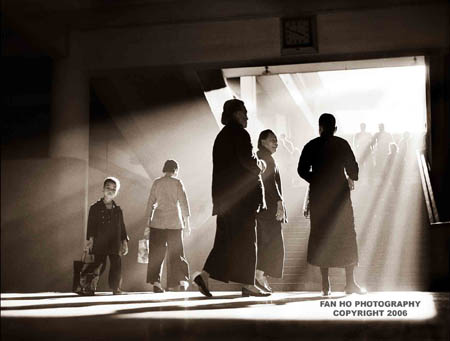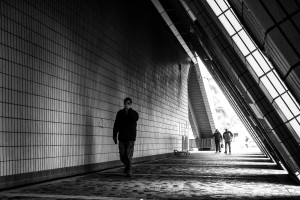Exercise 5.2
One of the most significant lessons I have taken from this course is the importance of maintaining a consistent theme throughout projects and assignments. With this in mind, I have endeavored to maintain a loose but cohesive theme centered around Hong Kong across my work. For this exercise, it felt fitting to engage with the world of the legendary Henri Cartier-Bresson, filtered through the lens of one of Hong Kong’s most celebrated photographers, Ho Fan.
Response to Afternoon Chat (1959) by Ho Fan
In Ho Fan’s Afternoon Chat, I am particularly drawn to two elements: the long shadows and the subtle, evocative lighting. His work conveys a profound sense of context and place, transporting viewers to the bygone era of mid-20th century Hong Kong. The interplay of light and shadow in the image is not merely visual but emotional, creating an ethereal atmosphere that feels timeless yet firmly rooted in its historical context.
Reflecting on Terry Barrett’s essay Photographs & Context, the power of Ho Fan’s work becomes even clearer. The context of the photograph—the information contained within the image and the circumstances of its creation—plays a crucial role in shaping its meaning. We know that the photograph was taken in 1950s or 1960s Hong Kong, during a period of rapid cultural and social transformation. Its value lies not only in its visual artistry but also in its ability to document and transport viewers to that era. For me, this photograph functions primarily as art, its artistry elevated by its documentary nature.
My Response to Ho Fan
In creating my response to Afternoon Chat, I aimed to replicate the essence of Ho Fan’s long shadows and evocative lighting. I chose to shoot around the walkways near the Hong Kong Cultural Centre, a location known for its striking diagonal architecture and the interplay of light and shadow it provides. My intention was to produce a work of art rather than a piece of reportage.
However, upon reviewing my resulting image, I began to see it in a different light. The man captured in the frame appears to react to the camera’s presence, adding layers of meaning that extend beyond my original artistic intent. This shift highlights how the meaning of a photograph can change depending on its presentation or the mindset of the viewer.
For instance, if this image were placed in a newspaper accompanying an article on criminal gangs, the man in the photograph might be interpreted as a shadowy figure—perhaps even a gang kingpin. In such a context, the high-contrast shadows I worked to achieve would likely be overlooked, their artistic significance lost amidst the constructed narrative of intrigue or criminality. Similarly, the image could be seen as a comment on the intrusion into private spaces caused by the ubiquity of cameras in modern urban life.
Reflection
This exercise reinforced for me the unpredictable nature of photography as a medium. While the photographer may have a clear intention during the act of creation, the final meaning of an image is ultimately shaped by the context in which it is viewed. This unpredictability can be both challenging and liberating, encouraging photographers to embrace the ambiguity inherent in their work.
Ho Fan’s influence on my response is evident not only in the stylistic choices I made but also in the way the exercise encouraged me to think about the layers of meaning in a photograph. The light and shadow I sought to emulate became not just aesthetic tools but gateways to deeper reflection on the complexities of perception, context, and interpretation.



